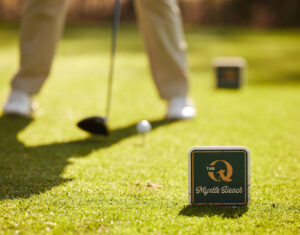Tip Tuesday: Takeaway Series Parts 2 and 3
In these follow-up segments, Dustin Johnson Golf School Director of Instruction Allen Terrell identifies the biggest flaw that many golfers have in the takeaway of their golf swing, and then shows us how to minimize it to get better results.
 So, the biggest flaw that we see for most amateurs in the takeaway is excessive forearm rotation in the very early part of the swing. When that happens, there has to be a lot of compensations going back to get the club in balance and get the sweet spot in a good position. So, our goal is to set up in a manner that when we swing back, the hands are fairly close to our trail quad or thigh here. The hands are somewhat over our right shoe, and the club in general terms is going to still be outside our hands at this position. A lot of times players will roll their arm, the arm goes out toward the ball, club face comes inside and open, and then halfway back is has pointed too far above the target line.
So, the biggest flaw that we see for most amateurs in the takeaway is excessive forearm rotation in the very early part of the swing. When that happens, there has to be a lot of compensations going back to get the club in balance and get the sweet spot in a good position. So, our goal is to set up in a manner that when we swing back, the hands are fairly close to our trail quad or thigh here. The hands are somewhat over our right shoe, and the club in general terms is going to still be outside our hands at this position. A lot of times players will roll their arm, the arm goes out toward the ball, club face comes inside and open, and then halfway back is has pointed too far above the target line.
They’re either going to have to have a really short swing to play from there or most times, if not, they’re going to lift their arms up, or they’re going to separate their arms at the top to try to generate some backswing. Both of those adjustments can create a lot of issues in your ball striking. So, again, our goal in the takeaway is to try to minimize the forearm rotation of the lead arm in the very early part of the swing. Remember, we talked about how if our arms are on the side, we don’t have any room to swing back, so they’re usually going to move away, or if we’re too close and this arm is too in, it doesn’t hang straight down from the shoulder joint to the elbow, there’s a good chance we’re going to make an adjustment, either out or doing something that’s going to create the forearm to rotate in a takeaway.
Why is that important? When we swing back and we rotate the left forearm too much, one is the club’s heavier. So, a lot of times a player’s going to make it steeper coming down, and that’s going to cause all sorts of issues in your golf swing and your ball striking. Our goal is to try to minimize the rotation, so we can get the club lighter at this point. Lighter is when the club is more directly over your hands. That’s going to enable us in transition to allow that club to get more behind her hands and generate a lot more club head speed, a lot more control of the clubface at impact, and a lot more control of the path coming through the ball.



